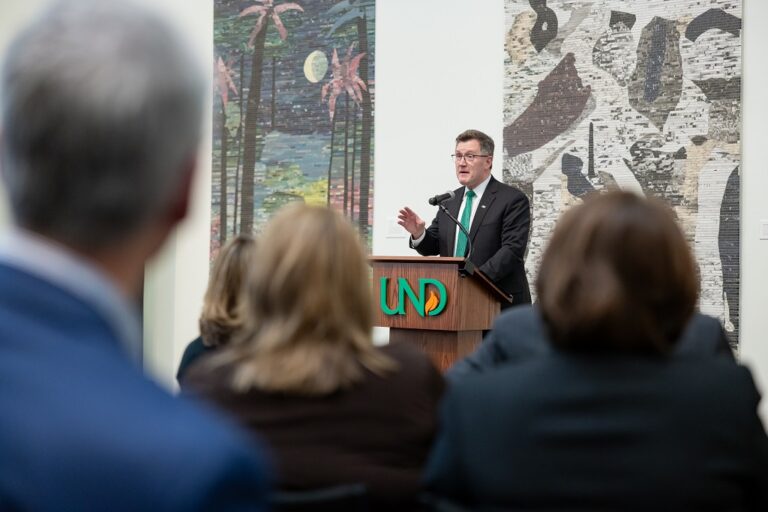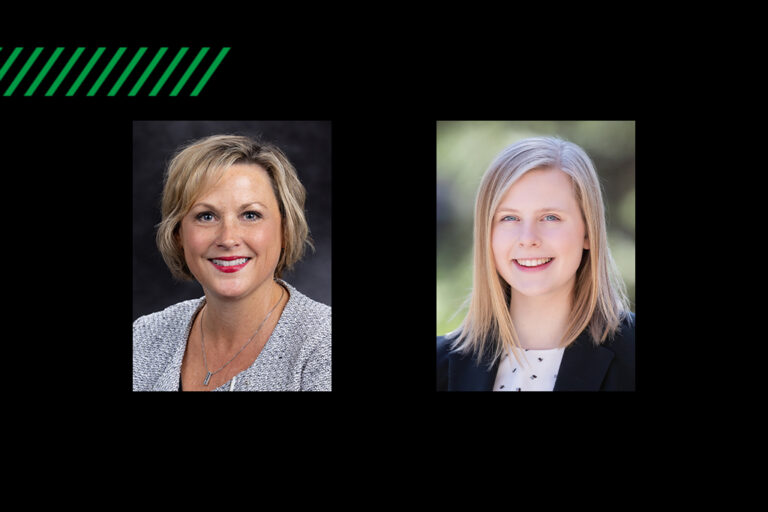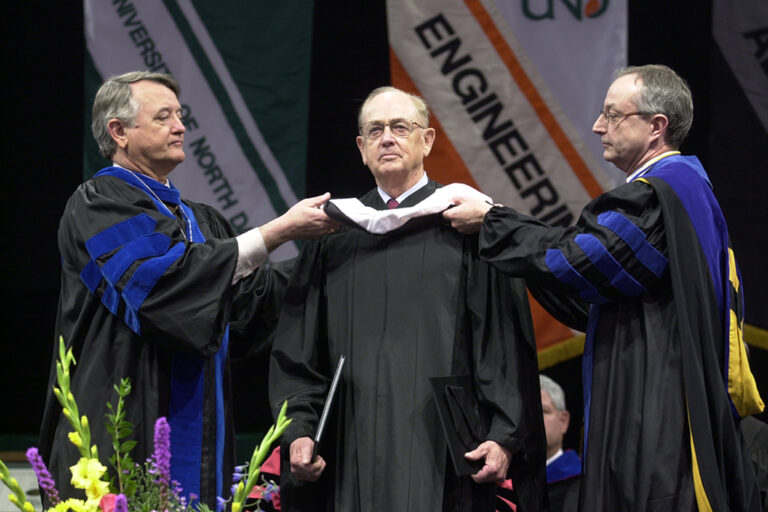The Shoulders of Giants
UND says goodbye to Dr. Robert Eelkema, a prime mover and all-time great advocate for School of Medicine & Health Sciences

The UND School of Medicine & Health Sciences lost one of its true “founders” last week.
Dr. Robert Eelkema, former professor and founding chair of the UND School of Medicine & Health Sciences, Department of Community Medicine and the Indians into Medicine and Physician Assistant Studies programs, died Dec. 27, 2021, in Grand Forks, N.D. He was 91.
Read Dr. Eelkema’s obituary here.
“It’s a cliche to say that those of us in leadership positions stand on the shoulders of giants, but in the case of Dr. Eelkema, it’s absolutely true,” said Dr. Joshua Wynne, dean of the SMHS and vice president for Health Affairs at UND. “Bob was a giant indeed and second to none. I’m so proud of the faculty, staff and students at the SMHS who have built on the solid foundational work and innovation of Dr. Eelkema.”
Rural medicine
As Wynne suggests, there truly never will be another Robert Eelkema. A UND grad, war veteran, veterinarian, physician and book author, Eelkema was instrumental in establishing not only the programs noted above but the four-year M.D. program at the SMHS in the early 1970s and UND’s world-renowned Center for Rural Health.
“In a way, he was our father,” added Brad Gibbens, acting director of the CRH, who knew Eelkema for decades. “The Center for Rural Health was technically part of Community Medicine; we were born out of it. After being one of the leaders for the school in the 1970s as it went through dynamic change, Dr. Eelkema came to realize (North Dakota) is very much a rural state and maybe we should have an office that focuses on rural (medicine). It was his idea that he then sold to Dean Tom Johnson to start an office. They found state dollars, hired a young doc finishing his medical residency (Dr. Kevin Fickenscher, who was from Bismarck, N.D.) to come back home to head it up and hit the ground running.”
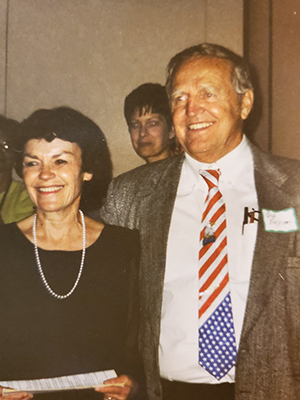
Today, the 40-years-young Center for Rural Health maintains a $10 million annual budget and touches each of the state’s 53 counties, providing technical assistance to all 38 rural North Dakota hospitals, 36 of which are Critical Access Hospitals.
And this isn’t even the most impressive of the Drayton, N.D., native’s accomplishments.
“I was out at Cass Lake (Minnesota) a while ago and fell and lacerated my arm,” Eelkema told North Dakota Medicine magazine in 2020. “We went to the Cass Lake clinic and one of our graduates was there and sewed me up. I felt pretty good about that.”
Speaking of a graduate of the SMHS Physician Assistant Studies program, the then-90-year-old recalled the anecdote with pride that this particular physician assistant, or P.A., in rural Minnesota was the product of a different UND program that Eelkema was right to speak of as “ours.”
The Medical Extension — or “MedEx” — program, which eventually would become the SMHS Department of Physicians Assistant Studies, was founded largely by Eelkema in 1970.
“Our goal was to get people out to provide health care in the boonies quickly,” Eelkema once said of the first-of-its-kind program dedicated to producing providers focused almost exclusively on rural communities. “We wanted the best way of doing it and wanted to get them employed right at the start, sort of like a deployment strategy.”
“Deployment” is the perfect word in this case. In the late 1960s and early 1970s, many corpsmen with a glut of trauma and other medical experience — but no medical degree — were returning from Vietnam and looking for work. Many of these former medics were interested in health careers but not necessarily medical school. And given the fact that this was an era before the “paramedic” was a career option in many states and nurses still were overwhelmingly female, a new profession had to be invented to accommodate the skills and experience of these veterans.
As Eelkema described the program’s founding, “The result would be an individual who could serve more or less as the medical extension of a doctor. They would become physician assistants or nurse practitioners. They wouldn’t replace a doctor but could, with training and close mentoring from nearby physicians, treat and resolve many of the basic medical issues common to underserved communities.”
INMED
This history is recounted in detail in Medicine in the Back of Beyond (2012), the second of two books Eelkema penned on the history of medicine in North Dakota. The first book, Good Medicine (2004), describes yet another program Eelkema helped establish in the early 1970s: UND’s award-winning INMED program.
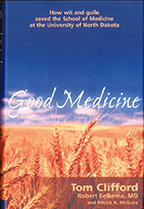 Up and running by 1973, when many similar programs were getting off the ground across the nation, INMED is arguably the preeminent Indigenous-focused health education program in North America. Its holistic programming starts with educating middle school students and taking them through high school and college, medical school and beyond, offering a Summer Institute for students in grades 7-12 and supporting medical and health professional students once they reach UND. Services include academic and personal counseling for students, assistance with financial aid applications and summer enrichment sessions at the junior high through professional or graduate school levels.
Up and running by 1973, when many similar programs were getting off the ground across the nation, INMED is arguably the preeminent Indigenous-focused health education program in North America. Its holistic programming starts with educating middle school students and taking them through high school and college, medical school and beyond, offering a Summer Institute for students in grades 7-12 and supporting medical and health professional students once they reach UND. Services include academic and personal counseling for students, assistance with financial aid applications and summer enrichment sessions at the junior high through professional or graduate school levels.
“We knew we had to encourage science and enrichment programs for (Indigenous) grade schools and high schools, so we developed a program that incorporated extra help in schools on reservations and brought students in for a summer program and worked with the medical school for students,” said Eelkema of the program’s early days.
To build support for the program, Eelkema and crew brought federal and state legislators to reservations across North Dakota to show them how much the Indigenous community supported the program designed to help them grow their own health providers.
“And we had a great president in Tom Clifford. He said, ‘It works — we’re gonna fly with it.’ So we put it all together and got the first grant,” Eelkema recalled.
As of 2020, the largely federally funded program has graduated 250 American Indian/Alaska Native physicians and countless more providers specializing in other fields. According to the Association of American Medical Colleges, this figure places the SMHS in the 100th percentile among medical colleges in the U.S. for the fraction of its M.D. class identifying as American Indian — first in the country.
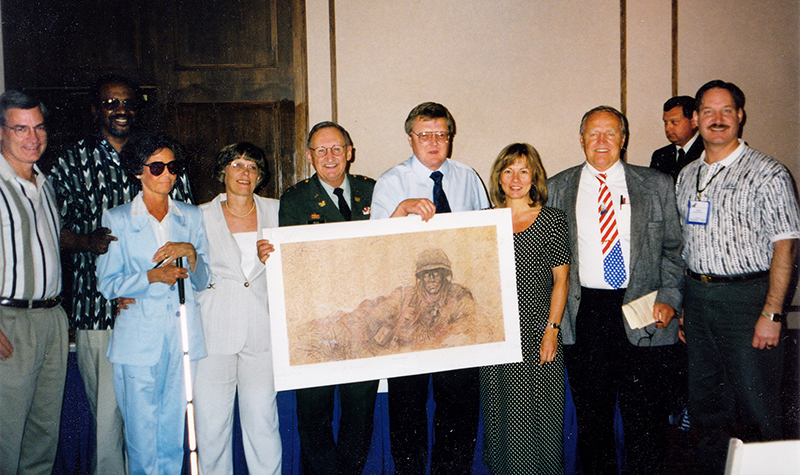
‘Most significant accomplishment’
Finally, in the 1980s Eelkema worked hard to improve conditions for persons with developmental disabilities in the state, overseeing the “deinstitutionalization” of such persons by helping them transition out of the Grafton State Developmental Center and the State Hospital in Jamestown and back into the community.
For this work, Eelkema was honored by the American College of Physicians with a Fostering Diversity Award in 2019. According to his obituary, Eelkema also was given UND’s Diversity of Medicine Award.
Describing his advocacy work in this arena, Eelkema wrote, “I think that we helped nudge the state toward providing better services to the developmentally disabled” in North Dakota. This work, he said, “was probably the most significant accomplishment of my life.”
Each of these efforts, significant in its own right, adds up to a career that did more than any other to impact health care in North Dakota in the past 50 years.
“I don’t think Bob ever got the recognition he deserved for these milestone projects,” mused Dr. Jim Brosseau, a longtime friend of Eelkema’s who succeeded the late physician as chair of what is now the Department of Family & Community Medicine at the SMHS. “But he was not one to seek personal aggrandizement. He believed in the ‘collaborative model,’ which meant involving all stakeholders before moving forward. He wanted everyone to have the opportunity to share in the responsibility and the success of these projects. Bob was a good man.”
“He was a kind and caring man, a true doctor, with a brilliant mind,” Gibbens said. “He used his intelligence and his heart to improve the world. I have fond memories of a truly great man and mentor.”

About the author
Brian James Schill is director of the Office of Alumni and Community Relations at the UND School of Medicine & Health Sciences.
